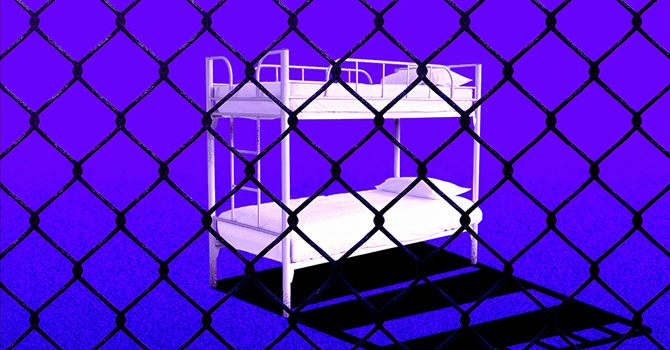Mental Health Inside Detention Centers: The Unknown Toll on Latinx Child Immigrants

Cecilia Galvan
Master’s Student in Social Work
In 2019, Immigration and Customs Enforcement (ICE) and Customs and Border Patrol (CBP) officers, inundated immigration detention centers along the southwestern border apprehending nearly 70,000 children in 2019.1,2 As a result, many of these children lacked consistent access to proper health care and to the developmental and educational opportunities which detention centers are lawfully required to provide.3 Never before has it been more evident that there is an immediate need to increase the amount of quantitative research being performed on the mental and behavioral health outcomes of Latinx migrant children detained in US immigration detention centers.
Strong data is necessary to help confirm the validity of the plight of these children to the wider public.
While there is strong data on the detainment of children globally, the US is significantly lacking in the amount of quantitative data being gathered and researched on this important health issue.4 Strong data is necessary to help confirm the validity of the plight of these children to the wider public, as well as to strengthen the understanding that the US immigration system is founded on racist practices and policies targeted toward Latinx populations.5 As a public, we must direct our attention to the fact that children are being targeted and extensively harmed in this system, and that the government is doing nothing to spare them from suffering. These data will help in advocating for their health and well-being so that this problem is no longer ignored and these children are not put in jeopardy as a result of their ethnicity.
The recent influx in immigration rates is attributed to those who originate from the Northern Triangle (Guatemala, El Salvador, and Honduras).6,7 However, misguided notions on the rates of Mexican immigrants coming to the US dominate and obscure the realities of the current immigrant population. In reality, immigration is a complex issue that involves a multitude of push and pull factors and a diverse representation of population demographics. However, a common underlying decision motivating immigration into the US is the assumption that there will be more humane circumstances and opportunities to be found once in this country.
Immigration is a complex issue that involves a multitude of push and pull factors and a diverse representation of population demographics.
Yet, contrary to this common assumption, extreme measures to curb immigrants, specifically of Latinx origin, from coming into this country have been implemented through strict immigration policies created by the Trump Administration.8,9 For example, the “zero-tolerance” policy refers migrants who cross the border without documentation to the Department of Justice to be criminally prosecuted, subsequently separating children from their parents in the process, and deliberately labeling these children as unaccompanied minors to be held in detention centers. Policies such as zero-tolerance have in turn steeply increased the number of detained migrant and immigrant children in the country.
Additionally, these policies have exposed a shift toward a system of “crimmigration”—a system that weaves the criminal justice and immigration systems into one and transforms immigration court proceedings into criminal prosecutions, while simultaneously promoting for-profit, prison-like detention centers.10 As a consequence, a hostile environment is created in these centers as migrant youth face inhumane and unlawful treatment, while their basic human rights are consistently violated due to being detained for indeterminate periods of time.
Young children are extremely vulnerable to environmental stressors.
Substantial research focused on child development and trauma has shown us that young children are extremely vulnerable to environmental stressors. For migrant and immigrant children, the stressors resulting from being detained are multiplied beyond those children studied in typical environments. Once detained and subsequently exposed to traumatic experiences, migrant children have exhibited high levels of mental, emotional, and behavioral consequences, only compounding the extent of damage to their development.11 The most common resulting symptoms include conduct and hyperactivity difficulties as well as reexperiencing of trauma. In addition, detained adolescents experience post-traumatic stress disorder at a rate of 12.3 percent higher than their American peers. Include the frequent stressors from parental separation, and immigrant children further face numerous other consequences such as strained parent-child relationships, self-harm, and withdrawal.12
When free of environmental stressors surrounding detainment, many immigrant children have shown positive academic attitudes and resiliency in their daily lives, leading to the assumption that their experiences pre-, mid-, and post-immigration have not yielded the same levels of trauma.13 This assumption furthers the argument against inhumane immigrant and migrant child detainment and emphasizes a clear need for researchers to direct their focus toward gathering substantive data on the short- and long-term health impacts. Such data can be presented to service providers and the general public in order to better inform the advocacy strategies detailed below.
How to Help
Placing onus on the current administration and holding them, and for-profit prison companies, accountable for the abuses being committed against migrant children is one strategy we can use to improve the immigration system for detained youth. We can accomplish this by pressuring Congress by means of lobbying, to hold an oversight hearing to review the executive branch’s immigration agency, the Department of Homeland Security (DHS). This would allow a congressional committee to review current immigration regulations and pressure DHS to humanely enforce them as well as create future regulations with more humane protections for youth, reflecting constituent opinion. Public pressure could also be implemented through the “notice and comment” process, facilitating a direct pathway for the public to voice opinions on proposed immigration regulations.
Individuals may also contact their local immigration organization to see how they may be of service. Common opportunities include providing free legal counsel, interning or volunteering, donating money or goods, and educating the public on this issue. You can also help differently documented Latinx families in your community to create a Family Preparedness Plan and build community networks that establish clear and safe guidance should they encounter facets of the immigration system.
By taking action at the community level, you build off the Social-Ecological and Macro-Level Social Work models, in that you promote communication and advocacy across multiple systems that disproportionately affect these youth, such as the immigration, health care, child welfare, and legislation. Emphasizing a strengths-based approach to service provision and advocacy, while prioritizing family diversity and other youth strengths as key components, encourages and empowers Latinx youth to develop self-advocacy skills.
Regardless of one’s strategy, it is important to advocate against the systemic abuses and traumas experienced by detained Latinx migrant children at the hands of the federal government and for-profit companies. These youth and their trauma exist regardless of data, and as informed professionals and public, it is our duty to bring light to their suffering by backing up their experience with science and compassion. Immigrant and migrant children matter, and they deserve to be fought for.
Notes
- Reichel, Chloe. “How Detention Centers Affect the Health of Immigrant Children: A Research Roundup.” Journalist’s Resource (July 22, 2019).
- Sherman, Christopher, Martha Mendoza, Garance Burke. “Nearly 70,000 Migrant Kids Were Held in US Government Custody in 2019.” Business Insider (November 12, 2019).
- Linton, Julie M., Marsha Griffin, Alan J. Shapiro. “Detention of Immigrant Children.” Journal of the American Academy of Pediatrics 139/5 (2017 May).
- Ortega, Debora M., Lisa Graybill, Christopher N. Lasch. “Enacting and Sustaining Trauma and Violence through Policy Enforcement: Family Immigration Detention.” Sage Journals 30/3 (July 2015):281-285.
- Sherman et al., “Nearly 70,000 Migrant Kids.”
- Ortega et al., “Enacting and Sustaining Trauma.”
- Cheatham, Amelia. “US Detention of Child Migrants.” Council on Foreign Relations (February 10, 2020).
- Provine, Doris M. “Institutional Racism in Enforcing Immigration Law.” Norteamérica 8-Supp (November 2013):31-53.
- Sherman et al., “Nearly 70,000 Migrant Kids.”
- Linton et al., “Detention of Immigrant Children.”
- MacLean, Sarah A., et al. “Mental Health of Children Held at a United States Immigration Detention Center.” Social Science and Medicine 230 (June 2019):303-308.
- Linton et al., “Detention of Immigrant Children.”
- MacLean et al., “Mental Health of Children Held.”
About the Author
 Cecilia Galvan is a master’s student at the University of Michigan School of Social
Work. She did research on mental and behavioral health impacts on children who have
spent time in immigration detention centers as part of her coursework in a Families and Health course taught by Linda Chatters, professor at the School of Public Health and the School of Social Work. Galvan has
a range of interests from juvenile justice to grass-roots community organizing to
immigrant/refugee social work but holds a specific interest in service provision for
youth.
Cecilia Galvan is a master’s student at the University of Michigan School of Social
Work. She did research on mental and behavioral health impacts on children who have
spent time in immigration detention centers as part of her coursework in a Families and Health course taught by Linda Chatters, professor at the School of Public Health and the School of Social Work. Galvan has
a range of interests from juvenile justice to grass-roots community organizing to
immigrant/refugee social work but holds a specific interest in service provision for
youth.
